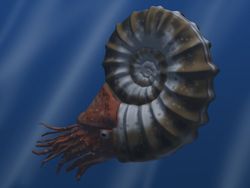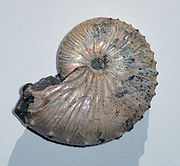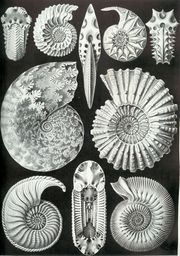Ammonite
| Ammonitida Fossil range: 200–65.5 Ma Early Jurassic – Late Cretaceous |
|
|---|---|
 |
|
| Artist's reconstruction of Asteroceras | |
| Scientific classification | |
| Kingdom: | Animalia |
| Phylum: | Mollusca |
| Class: | Cephalopoda |
| Subclass: | Ammonoidea |
| Order: | Ammonitida Hyatt, 1889 |
| Suborders | |
|
|
Ammonites, as they pertain specifically to the order Ammonitida, are an extinct group of marine animals belonging to the cephalopod subclass Ammonoidea. They are excellent index fossils, and it is often possible to link the rock layer in which they are found to specific geological time periods.
The closest living relative of the Ammonitida is not the modern Nautilus, which they somewhat outwardly resemble, but rather the subclass Coleoidea (octopus, squid, and cuttlefish).
Their fossil shells usually take the form of planispirals, although there were some helically-spiraled and non-spiraled forms (known as "heteromorphs"). Their name came from their spiral shape as their fossilized shells somewhat resemble tightly-coiled rams' horns. Pliny the Elder (d. 79 A.D. near Pompeii) called fossils of these animals ammonis cornua ("horns of Ammon") because the Egyptian god Ammon (Amun) was typically depicted wearing ram's horns.[1] Often the name of an ammonite genus ends in -ceras, which is Greek (κέρας) for "horn" (for instance, Pleuroceras).
Contents |
Classification
Suborders

Four suborders have been named for the Ammonitida.
- Phylloceratina (Lower Triassic to Upper Cretaceous)
- Ammonitina (Lower Jurassic to Upper Cretaceous) includes the true ammonites
- Lytoceratina (Lower Jurassic to Upper Cretaceous)
- Ancyloceratina (Upper Jurassic to Upper Cretaceous) the heteromorph ammonites
Taxonomy of the Treatise
The Treatise on Invertebrate Paleontology (1964) includes the Ammonitina, Lytoceratina, and Phylloceratina as separate suborders within the subclass Ammonoidea, without the use of orders, and divides them into superfamilies. In other, subsequent taxonomies the Ammonitina, Lytoceratina, and Phylloceratina are placed within the order, Ammonitida. The Ancyloceratina which is sometimes treated as a separate suborder is treated as a superfamily, the Ancylocerataceae in the Lytoceratina in the Treatise.
According to the Treatise, the Ammonitina are derived from the Phyllocerarina and Lytoceratina beginning in the Early Jurassic with the Psilocerataceae and ending with nine superfamilies, although not all extant at the same time. These are the Acanthocerataceae, Desmocerataceae, Eoderocerataceae, Haploceratacea, Hildocerataceae, Hoplitaceae, Perispinctaceae, Psilocerataceae, and Stephanocerataceae.
The Eoderocerataceae, Hildocerataceae, Psilocerataceae, and Stephanocerataceae are strictly Jurassic groups. The Acanthocerataceae, Desmocerataceae, and Hoplitaceae are known only from the Cretaceous. But the Haplocerataceae and Peripinctaceae extend from the Jurassic well into the Cretaceous.
Life


Because ammonites and their close relatives are extinct, little is known about their way of life. Their soft body parts are very rarely preserved in any detail. Nonetheless, much has been worked out by examining ammonoid shells and by using models of these shells in water tanks.
Many ammonoids probably lived in the open water of ancient seas, rather than at the sea bottom. This is suggested by the fact that their fossils are often found in rocks that were laid down under conditions where no bottom-dwelling life is found. Many of them (such as Oxynoticeras) are thought to have been good swimmers with flattened, discus-shaped, streamlined shells, although some ammonoids were less effective swimmers and were likely to have been slow-swimming bottom-dwellers. Ammonites and their kin probably preyed on fish, crustaceans and other small creatures, while they themselves were preyed upon by such marine reptiles as mosasaurs. Fossilized ammonoids have been found showing teeth marks from such attacks. They may have avoided predation by squirting ink, much like modern cephalopods; ink is occasionally preserved in fossil specimens.[2]
The soft body of the creature occupied the largest segments of the shell at the end of the coil. The smaller earlier segments were walled off and the animal could maintain its buoyancy by filling them with gas. Thus the smaller sections of the coil would have floated above the larger sections.[3]
Shell anatomy and diversity
Basic shell anatomy

The chambered part of the ammonite shell is called a phragmocone. The phragmocone contains a series of progressively larger chambers, called camerae (sing. camera) that are divided by thin walls called septa (sing. septum). Only the last and largest chamber, the body chamber, was occupied by the living animal at any given moment. As it grew, it added newer and larger chambers to the open end of the coil. A thin living tube called a siphuncle passed through the septa, extending from the ammonite's body into the empty shell chambers. Through a hyperosmotic active transport process, the ammonite emptied water out of these shell chambers. This enabled it to control the buoyancy of the shell and thereby rise or descend in the water column.
A primary difference between ammonites and nautiloids is that the siphuncle of ammonites (excepting Clymeniina) runs along the ventral periphery of the septa and camerae (i.e., the inner surface of the outer axis of the shell), while the siphuncle of nautiloids runs more or less through the center of the septa and camerae.
Sexual dimorphism

One feature found in shells of the modern Nautilus is the variation in the shape and size of the shell according to the sex of the animal, the shell of the male being slightly smaller and wider than that of the female. This sexual dimorphism is thought to be an explanation for the variation in size of certain ammonite shells of the same species, the larger shell (called a macroconch) being female, and the smaller shell (called a microconch) being male. This is thought to be because the female required a larger body size for egg production. A good example of this sexual variation is found in Bifericeras from the early part of the Jurassic period of Europe.
It is only in relatively recent years that the sexual variation in the shells of ammonites has been recognized. The macroconch and microconch of one species were often previously mistaken for two closely related but different species occurring in the same rocks. However, these "pairs" were so consistently found together that it became apparent that they were in fact sexual forms of the same species.
Variations in shape
The majority of ammonite species feature a shell that is a planispiral flat coil, but other species feature a shell that is nearly strght (as in baculites). Still other species' shells are coiled helically, superficially like that of a large gastropod (as in Turrilites and Bostrychoceras). Some species' shells are even initially uncoiled, then partially coiled, and finally straight at maturity (as in Australiceras). These partially uncoiled and totally uncoiled forms began to diversify mainly during the early part of the Cretaceous and are known as heteromorphs.
Perhaps the most extreme and bizarre looking example of a heteromorph is Nipponites, which appears to be a tangle of irregular whorls lacking any obvious symmetrical coiling. However, upon closer inspection the shell proves to be a three-dimensional network of connected "U" shapes. Nipponites occurs in rocks of the upper part of the Cretaceous in Japan and the USA.
Ammonites vary greatly in the ornamentation (surface relief) of their shells. Some may be smooth and relatively featureless, except for growth lines, and resemble that of the modern Nautilus. In others various patterns of spiral ridges and ribs or even spines are shown. This type of ornamentation of the shell is especially evident in the later ammonites of the Cretaceous.
Aptychus

Some ammonites have been found in association with a single horny plate or a pair of calcitic plates. In the past it was assumed that these plates served to close the opening of the shell in much the same way as an operculum, however more recently it has been postulated that they were instead a jaw apparatus.
The plates are collectively termed the aptychus or aptychi in the case of a pair of plates, and anaptychus in the case of a single plate. The paired aptychi were symmetrical to one another and equal in size and appearance.
Anaptychi are relatively rare as fossils. They are found representing ammonites from the Devonian period through those of the Cretaceous period.
Calcified aptychi only occur in ammonites from the Mesozoic era. They are almost always found detached from the shell, and are only very rarely preserved in place. Still, sufficient numbers have been found closing the apertures of fossil ammonite shells as to leave no doubt as to their identity as part of an ammonite. What exact function they serve is however not certain. One long-standing and widespread interpretation of them as a form of operculum has more recently been contested. The latest studies suggest that the anaptychus may have in fact formed part of a special jaw apparatus).
Large numbers of detached aptychi occur in certain beds of rock (such as those from the Mesozoic in the Alps). These rocks are usually accumulated at great depths. The modern Nautilus lacks any calcitic plate for closing its shell, and only one extinct nautiloid genus is known to have borne anything similar. Nautilus does, however, have a leathery head shield (the hood) which it uses to cover the opening when it retreats inside.
There are many forms of aptychus, varying in shape and the sculpture of the inner and outer surfaces, but because they are so rarely found in position within the shell of the ammonite it is often unclear to which species of ammonite many aptychi belong. A number of aptychi have been given their own genus and even species names independent of their unknown owners' genus and species, pending future discovery of verified occurrences within ammonite shells.
Soft parts
Although ammonites do occur in exceptional lagerstatten such as the Solnhofen limestone, their soft part record is surprisingly bleak - beyond a tentative ink sac and possible digestive organs, no soft parts are known at all.[4] It can be tentatively assumed that they had numerous tentacles, each quite weak, and engulfed prey almost whole.[4]
Size

Few of the ammonites occurring in the lower and middle part of the Jurassic period reach a size exceeding 23 centimetres (9 inches) in diameter. Much larger forms are found in the later rocks of the upper part of the Jurassic and the lower part of the Cretaceous, such as Titanites from the Portland Stone of Jurassic of southern England, which is often 53 centimetres (2 feet) in diameter, and Parapuzosia seppenradensis of the Cretaceous period of Germany, which is one of the largest known ammonites, sometimes reaching 2 metres (6.5 feet) in diameter. The largest documented North American ammonite is Parapuzosia bradyi from the Cretaceous with specimens measuring 137 centimetres (4.5 feet) in diameter, although a new 2.3-metre (7.5-foot) British Columbian specimen, if authentic, would appear to trump even the European champion.[5]
Distribution

Due to their free-swimming and/or free-floating habits, ammonites often happened to live directly above seafloor waters so poor in oxygen as to prevent the establishment of animal life on the seafloor. When upon death the ammonites fell to this seafloor and were gradually buried in accumulating sediment, bacterial decomposition of these corpses often tipped the delicate balance of local redox conditions sufficiently to lower the local solubility of minerals dissolved in the seawater, notably phosphates and carbonates. The resulting spontaneous concentric precipitation of minerals around a fossil is called a concretion and is responsible for the outstanding preservation of many ammonite fossils.
When ammonites are found in clays their original mother-of-pearl coating is often preserved. This type of preservation is found in ammonites such as Hoplites from the Cretaceous Gault clay of Folkestone in Kent, England.
The Cretaceous Pierre Shale formation of the United States and Canada is well known for the abundant ammonite fauna it yields, including Baculites, Placenticeras, Scaphites, Hoploscaphites, and Jeletzkytes, as well as many uncoiled forms. Many of these also have much or all of the original shell, as well as the complete body chamber, still intact. Many Pierre Shale ammonites, and indeed many ammonites throughout earth history, are found inside concretions.

Other fossils, such as many found in Madagascar and Alberta (Canada), display iridescence. These iridescent ammonites are often of gem quality (ammolite) when polished. In no case would this iridescence have been visible during the animal's life; additional shell layers covered it.
Ammonite fossils became less abundant during the latter part of the Mesozoic, with none surviving into the Cenozoic era. The last surviving lines disappeared along with the dinosaurs 65 million years ago in the Cretaceous-Tertiary extinction event. That no ammonites survived the extinction event at the end of the Cretaceous, while some nautiloid cousins survived, might be due to differences in ontogeny. If their extinction was due to a bolide strike, plankton around the globe could have been severely diminished, thereby dooming ammonite reproduction during its planktonic stage.
Mythology
In medieval Europe, fossilised ammonites were thought to be petrified snakes, and were called "snakestones" or, more commonly in medieval England, "serpentstones". They were taken to be evidence for the actions of saints such as Saint Hilda and Saint Patrick. Traders would occasionally carve the face of a snake into the empty, wide end of the ammonite fossil and sell them to the public. Ammonites from the Gandaki river in Nepal are known as saligrams, and are believed by Hindus to be a concrete manifestation of God or Vishnu.[6]
Terminological note
The words "ammonite" and "ammonoid" are both used quite loosely in common parlance to refer to any member of subclass Ammonoidea. However, in stricter usage the term "ammonite" is reserved for members of suborder Ammonitina (or sometimes even order Ammonitida).
See also
- Ammolite - a gemstone formed from fossil ammonite shells.
- Belemnoidea
- Coleoidea
- Fossils and the geological timescale
- Nautiloidea
References and further reading
- ↑ NH 37.40.167
- ↑ doi: 10.1007/978-1-4020-6806-5_11
This citation will be automatically completed in the next few minutes. You can jump the queue or expand by hand - ↑ "Introduction to Ammonoidea". The Geology of Portsdown Hill. http://www.bbm.me.uk/portsdown/PH_232_Ammonites.htm. Retrieved 2007-04-26.
- ↑ 4.0 4.1 doi:10.1111/j.0031-0239.2004.00408.x
This citation will be automatically completed in the next few minutes. You can jump the queue or expand by hand - ↑ "Ammonites". Hanman's Fossil Replicas and Minerals. http://web.archive.org/web/20030210130400/http://www.hanmansfossils.com/catalogs/fossils/ammonites/ammonites.shtml.
- ↑ "Fossils: myths, mystery, and magic". The Independent (London). 2007-02-12. http://news.independent.co.uk/sci_tech/article2259490.ece. Retrieved 2010-04-23.
- Neal L. Larson, Steven D Jorgensen, Robert A Farrar and Peter L Larson. Ammonites and the other Cephalopods of the Pierre Seaway. Geoscience Press, 1997.
- Lehmann, Ulrich. The Ammonites: Their life and their world. Cambridge University Press, New York, 1981. Translated from German by Janine Lettau.
- Monks, Neale and Palmer, Phil. Ammonites. Natural History Museum, 2002.
- Walker, Cyril and Ward, David. Fossils. Dorling, Kindersley Limited, London, 2002.
- A Broad Brush History of the Cephalopoda by Dr. Neale Monks, from The Cephalopod Page.
- Ammonite maturity, pathology and old age By Dr. Neale Monks, from The Cephalopod Page. Essay about the life span of Ammonites.
- Cretaceous Fossils Taxonomic Index for Order Ammonoitida
- Deeply Buried Sediments Tell Story of Sudden Mass Extinction
External links
- Descriptions and pictures of ammonite fossils
- goniat.org, a palaezoic ammonoid database
- paleozoic.org: gallery of ammonite photographs
- photos of ammonites at Lyme Regis, UK
- TaxonConcept's data on cretaceous ammonites
- The ammonites of Peacehaven - photos of giant cretaceous ammonites in Southern England
- tonmo.com: The octopus news magazine online, Cephalopod fossil articles.